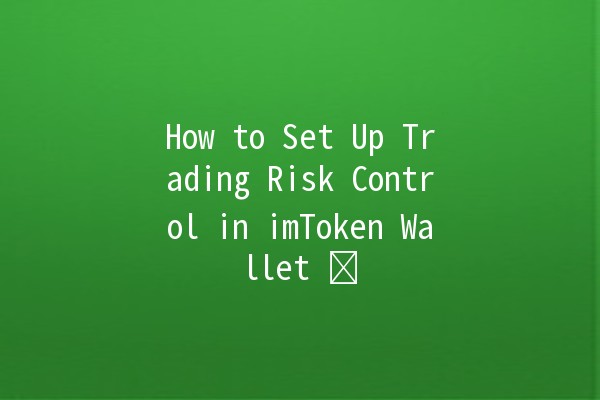In an increasingly volatile cryptocurrency market, managing trading risks effectively is crucial for both novice and experienced traders. The imToken wallet, known for its security and userfriendly interface, offers various features that can significantly enhance your trading risk control. This article will explore practical strategies for setting up trading risk control in the imToken wallet, focusing on actionable tips and techniques that can help mitigate potential losses.
Before diving into the specifics of using imToken for risk management, it’s important to understand what trading risk control entails. Essentially, it refers to the methods and practices that traders use to protect their capital from excessive losses. This can involve setting limits on orders, using stoploss orders, diversifying investments, and more.

Here are some effective strategies to implement risk control within the imToken wallet:
One of the simplest yet most effective methods to manage risk is by using stoploss and takeprofit orders. In imToken, you can set these orders directly when you're trading.
How to Implement:
When placing an order, specify a stoploss price below your entry point. If the asset’s price falls to this level, the sell order will trigger automatically.
For takeprofit, set a desired profit level so that when the asset reaches that price, your position is sold, securing your gains.
Example:
If you bought Bitcoin at $30,000 and want to limit your loss to 10%, set a stoploss order at $27,
Diversification is a fundamental risk management strategy. Instead of concentrating funds in a single cryptocurrency, spread your investments across various assets.
How to Implement:
Use imToken to acquire a mix of cryptocurrencies, such as Bitcoin (BTC), Ethereum (ETH), and governance tokens like Uniswap (UNI).
Monitor correlations between assets to ensure they behave differently under market conditions.
Example:
If you invest in both BTC and ETH, they may not move in tandem. When BTC drops, ETH might remain stable or even rise, helping balance your overall risk.
Establishing a maximum percentage of your capital that you are willing to risk per trade can keep your losses manageable.
How to Implement:
Decide on a percentage (commonly 12%) of your total capital.
For example, if your portfolio is worth $10,000 and you’re willing to risk 1%, you would only risk $100 on each trade.
Example:
If you are trading with a risk per trade of $100 and your stoploss is set at 10%, you should only buy $1,000 worth of the asset, ensuring that if things go wrong, your potential loss remains within your risk appetite.
Staying informed about market trends is crucial in adjusting your risk management strategies dynamically.
How to Implement:
Regularly check market news and updates through the imToken wallet's builtin market tracker or external sources.
Use charts and indicators to analyze trends and volatility.
Example:
If you notice increased market volatility or news affecting a specific cryptocurrency negatively, consider reducing your position size or temporarily exiting that asset.
Knowledge is power in trading, and staying educated on risk management strategies can significantly improve your trading results.
How to Implement:
Read research papers, articles, and tutorials on risk management and trading psychology.
Join online forums or communities that discuss crypto trading strategies and experiences.
Example:
Participating in webinars or online courses on trading strategies can provide insights that you may apply directly within imToken, enhancing your overall risk control.
Stoploss orders are crucial in limiting your potential losses on trades. By setting a predetermined price at which your assets will be sold, you avoid emotional decisionmaking during market fluctuations. This ensures that your losses do not exceed your risk tolerance, which is especially vital in the unpredictable world of cryptocurrency trading.
To diversify, consider spreading your investments across various cryptocurrencies rather than concentrating on one. You can analyze the market to identify different cryptocurrencies that exhibit low correlations with one another. Utilizing imToken, you can easily purchase and store multiple assets, thereby helping to mitigate risk through diversification.
If your stoploss order is triggered, it means that the market has hit the price you set to limit your losses. It's essential to stick to your trading plan and not alter your stoploss after it has been set, as this can lead to emotional trading and greater losses. Assess the market conditions before deciding your next steps, whether it's to enter a new trade or hold off for a while.
Your risk management strategy should be dynamic. Keep informed about the market through news and analysis. If you observe increased volatility, consider reducing your position sizes or tightening your stoploss orders. Conversely, during stable market phases, you might choose to expand your positions within your risk tolerance.
Yes, engaging with trading communities can be very beneficial. You gain insights from experienced traders, can share risk management strategies, and learn from the mistakes and successes of others. Interaction with peers may also provide emotional support, which is critical during turbulent market phases.
To measure trading performance, keep a trading journal that logs each trade, including entry and exit points, the rationale behind each decision, and the outcomes. This reflection allows you to analyze what strategies are working and which need adjustments, providing valuable insights into your trading habits and the effectiveness of your risk management strategies.
Effective risk management in trading is not just about protecting yourself from losses; it’s about creating an environment where your portfolio can grow sustainably. By utilizing imToken’s features strategically, you can establish a robust framework for managing trading risks, ultimately leading to more informed trading decisions and better financial outcomes.